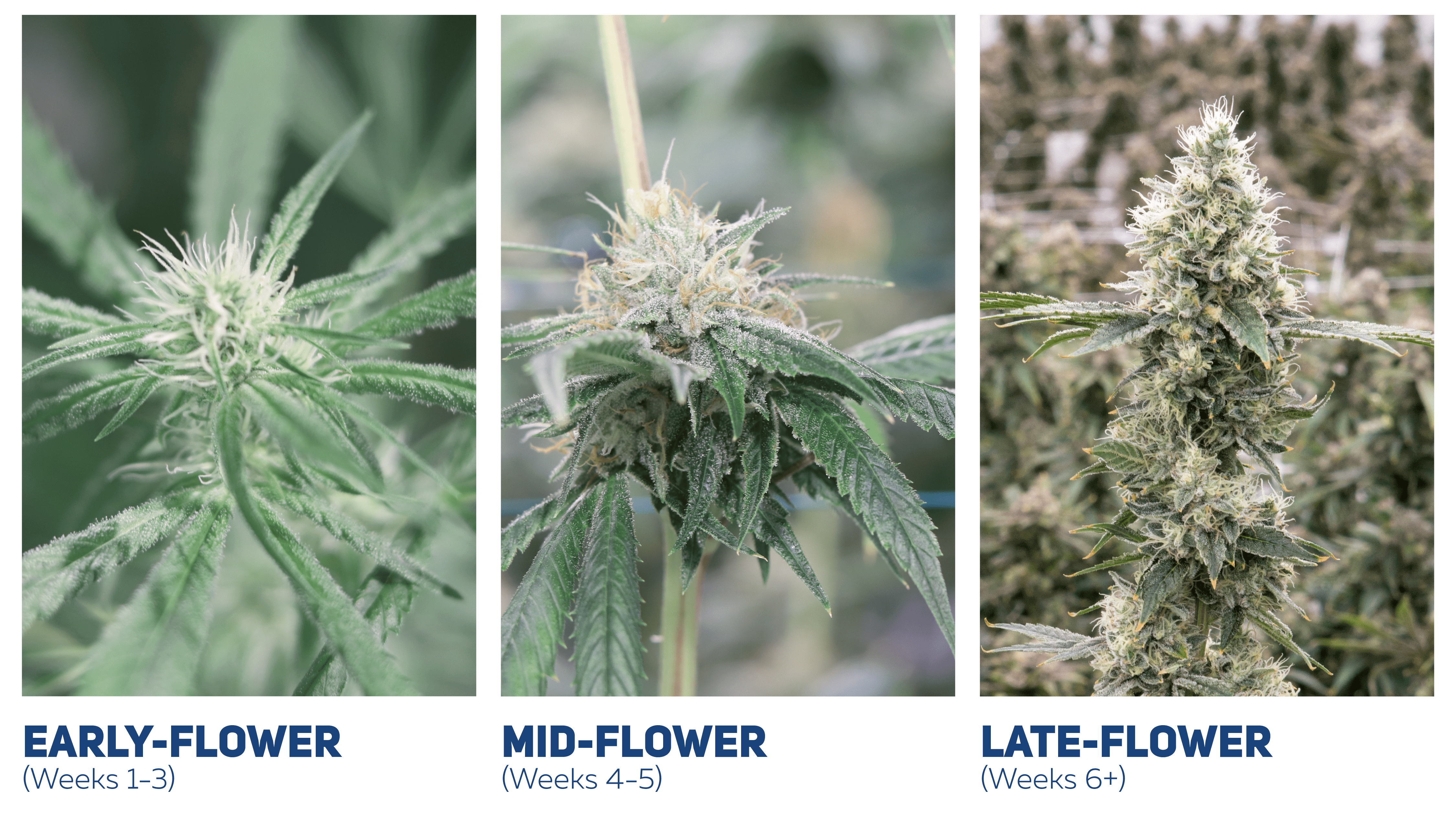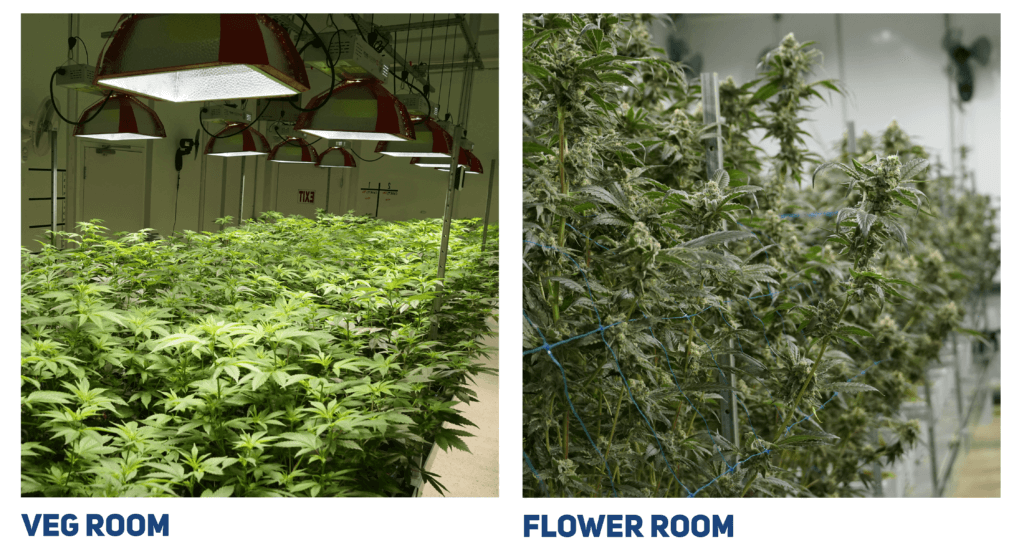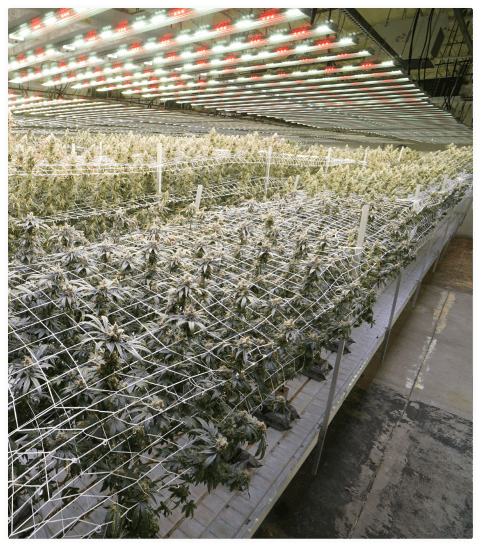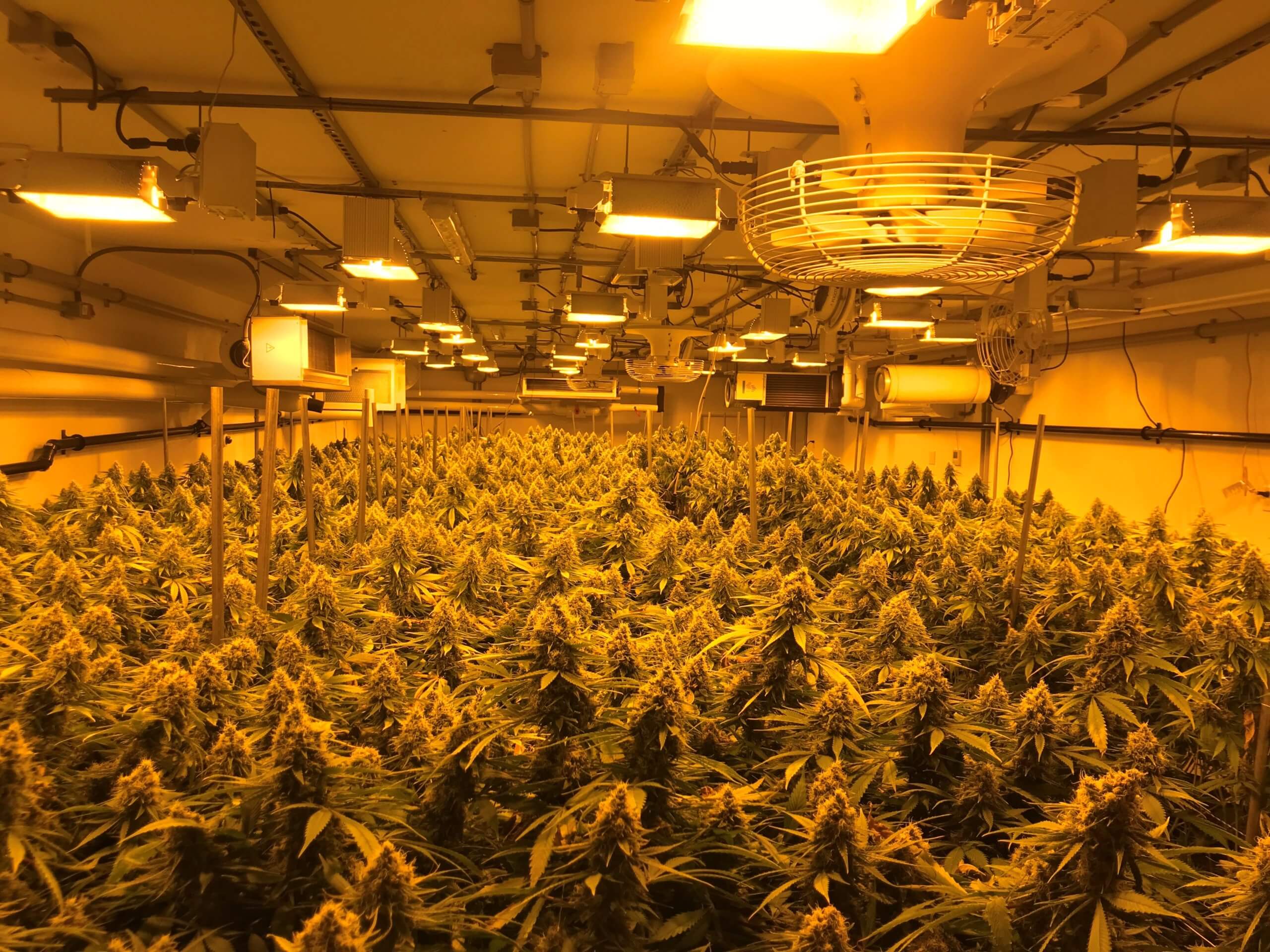Cannabis will spend the bulk of its life in two major phases of growth: veg and flower. While the vegetative stage involves rapid growth and elongation, the flower stage is where things get exciting. This is the part of the female plant’s growth cycle in which you will begin to see bud sites develop signs of flowering. Eventually, your plants will be chock-full of sticky, aromatic colas ready for harvesting.
There are distinct differences between the ideal growing conditions for veg and flower that are worth noting when designing a flower room. These differences will influence your selections for climate control, lighting, benching/racking, and operations. Check that your MEP designer has experience with previous commercial cannabis cultivation projects to help ensure they are qualified to satisfy your CEA needs.
Flower Stage
The flower stage marks the final phase of the cannabis plant growth cycle. After plants are rooted from seed or cutting, they are moved to the vegetative stage of growth, where they receive 18-24 hours of light per day. Vegetative growth periods vary depending on the size of flowering plants cultivators are after, but in most cases range from 2-4 weeks in indoor facilities, and may continue for up to 16 weeks in outdoor farms. (The cannabis plant can be kept in a vegetative phase indefinitely in a controlled environment, because the cannabis plant flowers based on a photoperiod of 12 hours of light/12 hours of dark). Once you are satisfied with the size of the vegetating plants, you can “flip” them to flower by changing the photoperiod.
There are several principal flowering stages:
- Early-Flower (week 1-3 of flower): Rapid growth will occur as the plant prepares to support heavy buds. You will notice sticky resin on the leaves, and small white hairs called “pistils” forming at the bud sites. These form in the plant nodes where the stem meets the leaf branches.
- Mid-Flower (week 4-5 of flower): The plant will slow or stop growing in size as it directs its energy into producing buds.
- Late-Flower (week 6+ of flower): During the final weeks of flower, buds will become fatter and sticky with THC-rich trichomes.
- [Optional] Flushing (1-2 weeks before harvest): To prepare for harvest, growers may opt to “flush” their plants with excess water free of nutrients and fertilizers. This process forces the plant to utilize the remaining nutrients and can produce a smoother flavor and aroma.

Maintenance During Flower
During flower, some leaves may begin to turn brown and fall off. This is normal and indicates nutrients are being redistributed. But if too many begin falling off, it could be a sign of a problem like nutrient deficiency, light burn, or nutrient burn.
While you should continue to defoliate as needed to remove leaves that are blocking light to critical areas, or leaves that aren’t receiving light, be careful not to trim away bud sites or to damage the plant. You may have success with stress-training during veg, but stressing your plants during flower will take away from the energy they need to put into flowering. Similarly, any climate or nutrient changes you make should be done gradually over time to avoid shocking the plant.
Plants in flower require less humidity than those in veg, but they can still be susceptible to mold and mildew infestation even if conditions are optimal. Frequently examine your plants to check for signs of disease and fungi. Because it begins in the cola, bud rot can be especially difficult to catch. The best way to prevent mold and mildew from taking root in your flower room is by ensuring that your environmental parameters are correct and consistent, and that biosecurity SOP’s are developed and closely adhered to.
What is a Flower Room?
A “flower room” is a space designated for mature plants to begin forming buds which can then be harvested for drying and curing. Plants are moved from veg to flower when they are mature enough to support heavy clusters of buds. There are two ways for commercial cannabis facilities to transition from veg to flower.

The first and most common way is to re-locate plants from the veg room to the flower room. In this method, the rooms are separate. As one batch of mature plants leave veg, a new batch is brought in from the nursery to begin again. And as one crop is harvested in the flower room, another is brought in from veg. Rooms should be cleaned and air filters replaced between batches. While this method requires more labor, it allows you to select specific lighting and benching equipment for both growth phases, and results in more annualized harvests
The second method is to veg and flower in the same room. Here, the plants are not relocated, but the lighting and HVAC parameters are modified to promote flowering. With this method, once a plant is moved from the nursery into a grow room, it stays until harvest. Multiple rooms can be used to grow multiple harvests at one time, all started at different intervals. Again, it’s a good idea to clean your rooms and replace air filters between harvests. While this method is less labor intensive, it requires grow room equipment that is flexible enough to accommodate the needs of both veg and flower, and limits the number of annualized harvests.
How to Set Up a Cannabis Flower Room
It is important that you properly design your flower rooms to accommodate the space planning, lighting, and HVACD requirements of cannabis. When using separate rooms for nursery and vegetative growth, usually 2/3 – 3/4 of the total cultivation square footage will be dedicated to flowering.
Benching and Racking
The square footage available to you will hep determine the best way for you to maximize your grow space. Plants in flower are at their largest, and depending on the strain, can grow quite tall. Most growers use single-tier grow tables or 2-tier racks to organize their plants. Growing on a single tier is ideal for cultivators with plenty of space, while those with space limitations (whether due to available land or the cost of real estate) can maximize their square footage with two-tier grow racks. Benches and racks can be stationary or mobile, providing even more options for space utilization.
Ideal Lighting for Flower
Regardless of whether you are using HID (high intensity discharge) lighting or LED (light emitting diodes), ensure that the light you choose is full spectrum. The cannabis plant uses different spectrums of light in different ways, but ultimately uses every color in the spectrum in some way to maximize flower potential. In general, flowering plants appreciate an uptick in the red spectra, while vegetative plants need a little extra blue.
Cultivators are increasingly opting against HID lighting in both veg and flower, although LEDs remain most popular in the vegetative growth phase. LEDs are more efficient at turning energy into useful light for the plant, and produce less waste heat than HID lighting (although watt for watt, they ultimately produce the same amount of sensible heat, more of the LEDs energy is converted to light). This usually means that LEDs are either implemented at lower wattage for the same lighting output, or at a similar wattage to HIDs but with more lighting output. When lower wattages are implemented, the reduction in sensible heat loads may reduce the size of the HVAC system somewhat as well.

While there are a number of terms and measurements that apply to lighting, the two most important to understand for cultivators are PAR (photosynthetically active radiation—this is the light that is useful to the plant) and PPFD (photosynthetic photon flux density—this is essentially the amount of PAR that lands on the canopy and is measured in micromoles per meter per second). When you work with your lighting manufacturer, they will typically ask you what PPFD you are targeting at the canopy and will put together a light map that achieves that target. Most cultivators in cannabis facilities target a PPFD in the neighborhood of 900-1000 micromoles for flowering plants.
What’s the Best Temperature and Humidity for Flower?
The exact climate is up to the discretion of the grower, but generally the flower room will be a bit dryer and a bit cooler than in veg. Maintain 45-60% humidity and 75-84°F lights on / 65-75°F lights off for best results.
Avoid excessively high temperatures especially in late-flower, as this could dry out your plants during a time when they should be putting all of their resources into producing buds. Avoid excessively high humidity, especially in late flower, which is when the plants are most susceptible to mold and rot (and when you are irrigating at the highest volume). Similarly, keep in mind that you will have shorter photoperiods during flower. Maintaining humidity during lights off is extremely important, and becomes a bit more difficult without the heat from the lighting systems forcing the climate control system to work and dehumidify as a byproduct of cooling. This is exacerbated by the lower night time temperatures, which cause higher relative humidity due to contraction of air, even with the same volume of water present in the space. Work with experienced MEP designers to ensure they understand what you need and how to accomplish it.
Flipping From Veg to Flower
Once your plants have spent enough time bulking up in veg, it’s time to trigger flowering. During the veg stage, cannabis focuses its energy on growing taller and fuller. When it is strong, healthy, and mature, you can manipulate your lighting schedules to signal to the plant that it is time to begin producing buds.
When Should You Switch from Veg to Flower?
Longer veg times can increase yields by giving the plant time to strengthen its stem and stretch itself. But as a commercial grower, you must balance time to market with yield output. Most indoor cultivators leave their plants in veg for 2-4 weeks. You can also test methods for stress-training and pruning your plants to manipulate them into yielding more.
Typically, you will know that your plants are ready for flowering when they have achieved a certain portion of their vertical growth. This will vary, so understanding the typical growth expressions of the strains you select will be important. Here is a common general guide for when to flip your cannabis:
- “Tall” strain (like Sativa): approximately 1/3 the final desired height
- “Short” strain (like Indica): approximately 1/2 the final desired height
How to Transition from Veg
Outdoors, cannabis takes its cues to begin flowering from the sun. As nights grow longer, ushering in cooler weather, the plant signals that it must prepare for reproduction before the end of the season. If you are growing in a sealed environment, you can manipulate your lighting schedules to force flowering.

Flowering is triggered when a cannabis plant is exposed to periods of uninterrupted darkness of more than 12 hours. You can accomplish this transition by either adjusting the lighting schedule within the veg room, or by relocating the plants into a flower room with lights on a flowering lighting schedule. Again, both options carry their own benefits and drawbacks.
Regardless, you will also need to alter your climate parameters to serve the plant’s needs during flower. A climate that is cooler and less humid than veg is better suited for this stage of the growth cycle. Coordinate this with your MEP engineer to ensure your HVACD system is properly designed to meet your desired setpoints.
Due to their different lighting and climate needs, you cannot veg and flower cannabis in the same room at the same time. Keep this in mind when planning your facility layout and harvest schedules.
Autoflowering Cannabis
Unlike photoperiod cannabis, autoflowering strains do not rely on a shift in the lighting cycle to trigger flowering. Autoflowers developed in cooler regions with short growing seasons, and rather than waiting for the sun to indicate seasonal changes, autoflowers adapted to automatically begin flowering after 3-4 weeks in veg.
While autoflowers have a conveniently shorter life cycle, minimizing harvest times, they are also limited by their size and quality. Autoflowers tend to produce smaller yields than photoperiod strains. They are also not suitable for cloning since the clone will inherit the age of the mother plant. This can be a major turnoff for commercial operators who seek genetic consistency. As a result, the vast majority of commercial cultivators do not use autoflowering strains, and instead rely on manipulating the photoperiod to maximize yield and quality.
Ready to Start Planning Your Flower Room Design?
Surna Cultivation Technologies can provide everything you need to bring your operation to life including architectural design and floor plans, MEP engineering, benches and grow racks, LED lights, and more. Contact us today to discuss your goals.

